Simon Schama on art’s return to the barricades
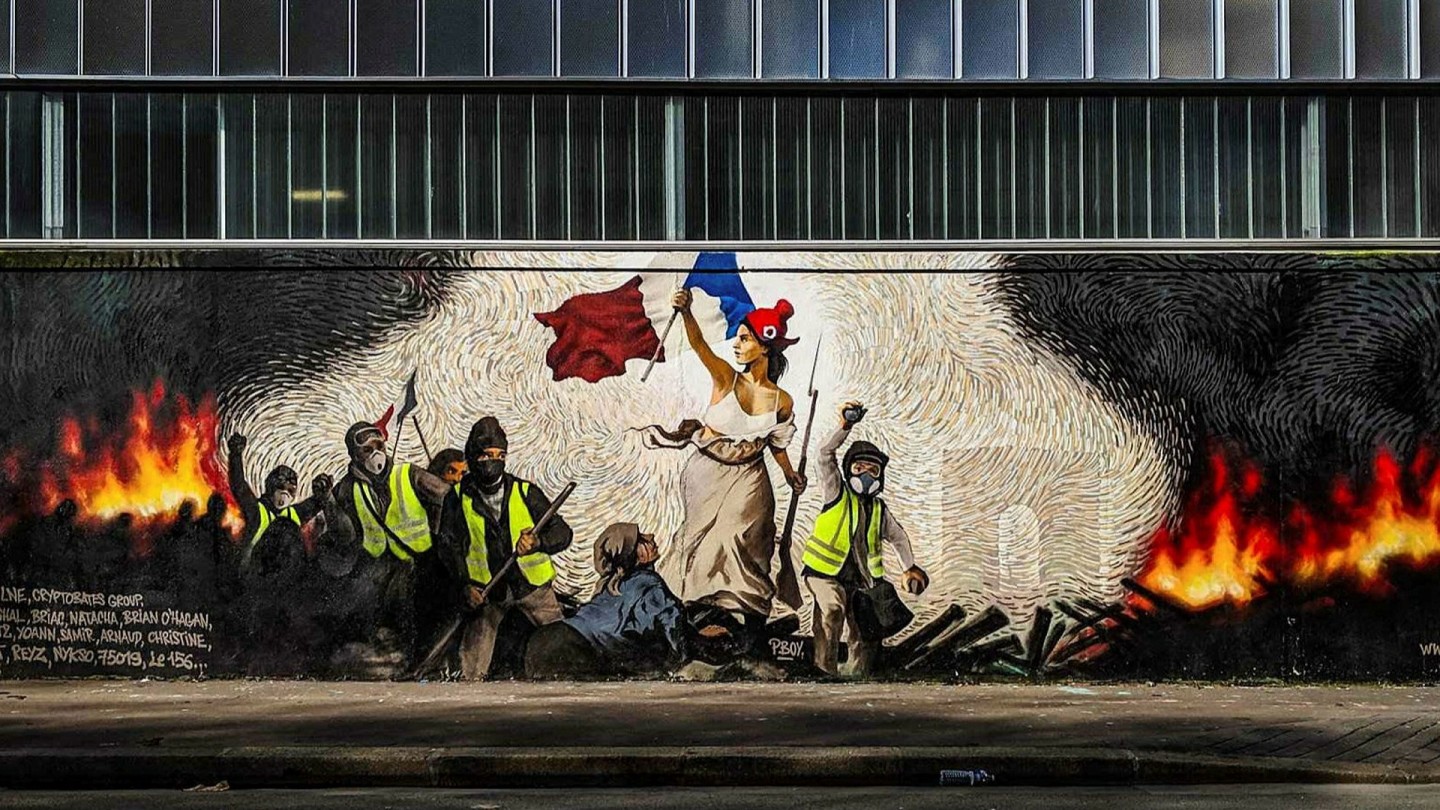
Simply sign up to the Life & Arts myFT Digest -- delivered directly to your inbox.
The times that try us can also be the times when words fail us. Caught between platitudes and histrionics, between the craving for normality and the need to articulate the perils of the moment, we fall back on the daily drone of commentary and the circumlocutions of politics. Into the space opened by this inadequacy come the howls of tribal fury: the shrieking tweet, the burning building, the rattle of gunfire. Or, if it can manage to rise to the moment, art.
Wishful thinking? Perhaps. But if we want to sense the terror inflicted by bombing on civilians with unparalleled immediacy, we look at Picasso’s “Guernica”. If we feel the need to look at the unwatchable, say, a firing squad emptying their rifles on a civilian, we find our way to Goya’s “The Third of May 1808”.
No historical document has ever matched the spectacle of that dirty deed done in darkness, the victim-martyr’s arms flung wide in the attitude of the crucified Saviour, a hand already bearing the stigmata and the executioners reduced to a faceless killing line. To dive into the abyss of Auschwitz, we read Primo Levi rather than a transcript of the Nuremberg trials. And if we want the first great statement of the power of peaceful civil disobedience there are the adamant quatrains of Percy Bysshe Shelley’s “The Masque of Anarchy”:
Stand ye calm and resolute,
Like a forest, still and mute,
With folded arms and looks which are
Weapons of unvanquished war
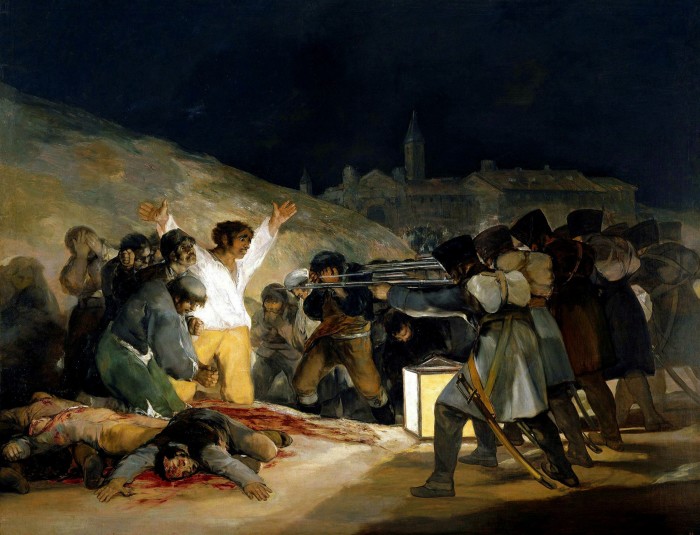
Shelley wrote his poem as a response to the Peterloo massacre in 1819, when the Manchester yeomanry rode down and sabred a crowd listening to Orator Hunt’s demands for parliamentary reform. Shelley was then safely in Italian exile; his English friends who had sent him news of the atrocity and were themselves under surveillance judged it too radical to be safely published. But the noble drama of non-violent resistance standing firm against brutal policing lives today in the streets of Minsk and Hong Kong, as it did in Gandhi’s India, Mandela’s South Africa and Martin Luther King’s Alabama march.
It is easy enough to chuckle at Shelley’s naïveté when he asserted that “poets are the unacknowledged legislators of mankind” — in effect, the instigators of disaffection, the shapers of allegiance. But there are moments when that’s what happens; when Václav Havel, for example, shook the Communist regime and became its successor.
We are accustomed to think of creative departures in the arts as happening serially, safely encapsulated within their assigned place in a procession of isms, usually by way of rejecting the norms and conventions of their predecessors. Thus neoclassicism purified the sensual ornamentalism of rococo; then was itself rejected as so much chilly sermonising by Romantics like Eugène Delacroix who embraced colour, commotion and sensationally visceral drama. The icon-maker of “Greece on the Ruins of Missolonghi” would in turn become an established master; enter Realism’s scientifically dry-eyed correction of Romanticism’s sentimental theatrics.
But the most powerful Romantic art jumps the line. Its reliance on emotional connection, its preference for imaginative heat over cool calculation, the fellowship of the crowd over individual reasoning, all made it the perfect vehicle for the age of democratic mobilisation while also liberating the visceral passion of popular nationalism. All those qualities, both the exhilaration and the vehemence, continue unabated into our own times. The street wars of the American election are just the latest example of the enduring force of what Romanticism inaugurated.
During the 1968 May demonstrations and marches of students and workers in Paris that came close to bringing down de Gaulle’s government and shaking the foundations of the Fifth Republic, the most famous icon of popular insurrection, Delacroix’s “Liberty Leading the People”, was everywhere. Women, including the young English model Caroline de Bendern, were hoisted on the shoulders of marchers and photographed waving a flag (in her case that of the Viet Cong rather than the Tricolor). Variations of the painting appeared on posters and pamphlets. And no wonder, since no other image has ever captured the adrenaline rush of the crowd with such force or remade a classical symbol — Liberty wearing the red Phrygian cap which, in antiquity, signified the alteration from slavery to freedom — with such directness.
The Revolution of 1789 and its artistic orchestrators such as Jacques-Louis David had repurposed the image from classical coins and medals. Turned into a three-dimensional figure in pageants and festivals, Liberty superseded the Virgin as the focus of a new devotion. But as the image became authoritative under revolutionary governments, so it lost its liberating energy.
FTWeekend Festival
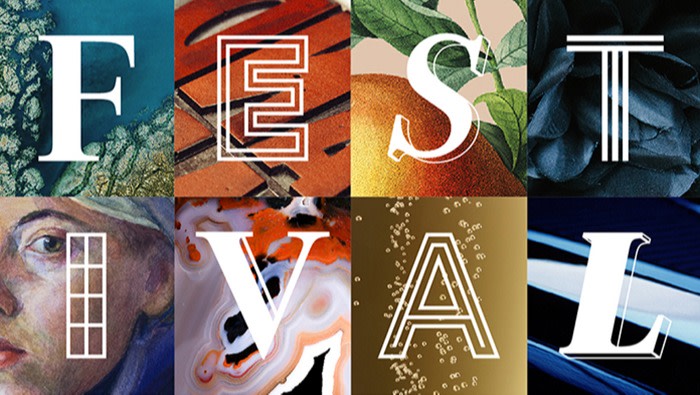
Simon Schama will be discussing his BBC series ‘The Romantics and Us’ with FT arts editor Jan Dalley on the concluding evening of the FTWeekend Festival this Saturday. For more information and to purchase a festival pass visit: ftweekendfestival.com
Delacroix changed all this when, following the July days of 1830 that toppled the Bourbon King Charles X and replaced him with the constitutional monarch Louis-Philippe, he wrote to his brother that he was painting “a barricade . . . If I cannot fight for my country at least I can paint for it”. Delacroix turned an emblem into a physically embodied woman. Her exposed breasts recalled the Virgin’s exposure as an act of intercession for sinners, but his street-fighting Madonna came with hairy armpits and flushed cheeks.
With this one democratic altarpiece, modern revolution painted its own gospel myth: the unity of the righteously indignant people. Delacroix spread his casting net wide to include the brawny worker gazing adoringly at Liberty; the student, the pistol-toting street urchin and a top-hatted liberal professional all gathered together in the onrush, notwithstanding the differences of class and language that would (as happened again in 1968) inevitably separate them.
Delacroix’s picture is not painted sociology but a moment of mystical communion when all those differences melt into the exhilarating togetherness of the crowd. That provisional union happened again last year when middle-class Greens joined with working-class gilets jaunes, even though the first group wanted climate change action and the second lot were enraged by Macron’s proposed tax on gasoline. And just as Delacroix’s painting was bought by the state and kept hidden until it was returned to the artist lest it incite a new round of inconvenient acts of rebellion, so an updated version of Liberty appearing as a mural was whitewashed over by the Parisian authorities.
But the urge to make political art in troubled times is irrepressible. At the end of the first episode of our BBC2 television series, The Romantics and Us, a drone camera finds a young graffiti artist known as PBoy (or Pascal Boyart) painting his updated version of Théodore Géricault’s “The Raft of the Medusa” on the roof — significantly — of a former gold foundry on the outskirts of Paris.
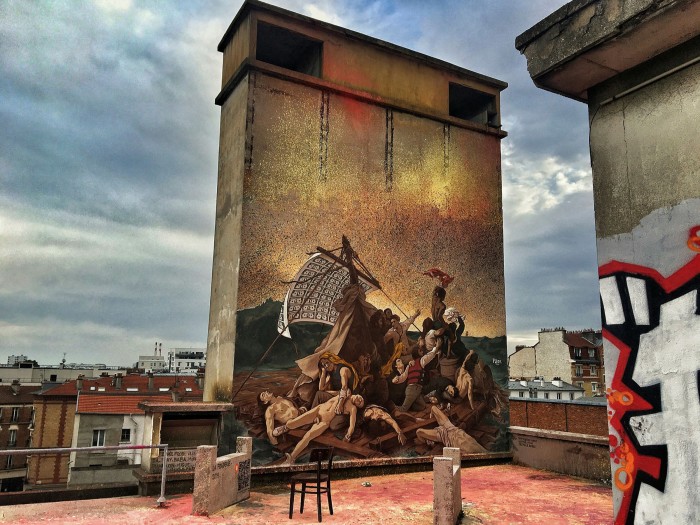
The wiring between the original and Boyart’s version hardly needs forcing. Géricault was triggered to make his own colossal disaster epic of abandoned souls by newspaper stories of a maritime calamity and followed it up by talking to two of the survivors who had published their accounts. Boyart, who was also responsible for the Liberty mural, uses images and reports of the desperate of our own time, foundering in their rubber dinghies or washed up lifeless on the shore. For both artists the pathos and cruelty of abandonment functions as commentary on the injustices and inequalities of their times. The historian Jules Michelet was right when he commented in a lecture in the 1840s that for Géricault “our whole society was aboard the raft of the Medusa”. Boyart says that the raft is “a metaphor to show we are all on the raft”, adding that the Romantics were “the first artists who started to answer back to power”.
To contemporaries the grim story seemed exemplary. The Medusa was taking passengers to west Africa to re-establish the French colony of Senegal in the summer of 1816 when it ran aground off the coast. The aristocratic captain, a friend of King Louis XVIII, reserved the few lifeboats for the well-to-do officials and merchants while the hoi polloi were packed on to a makeshift raft with almost no provisions or water. The lifeboats were meant to tow the raft to the coast, but when the sheer weight of numbers made progress impossible, the captain cut the connecting ropes, guaranteeing a death sentence for the occupants of the raft. Horrors — drowning, murders, cannibalism — ensued. When rescuers arrived on the scene 15 days later they found strips of human flesh, nailed to the mast to dry out. Just 15 of the original 146 had survived and not all of those made it back.
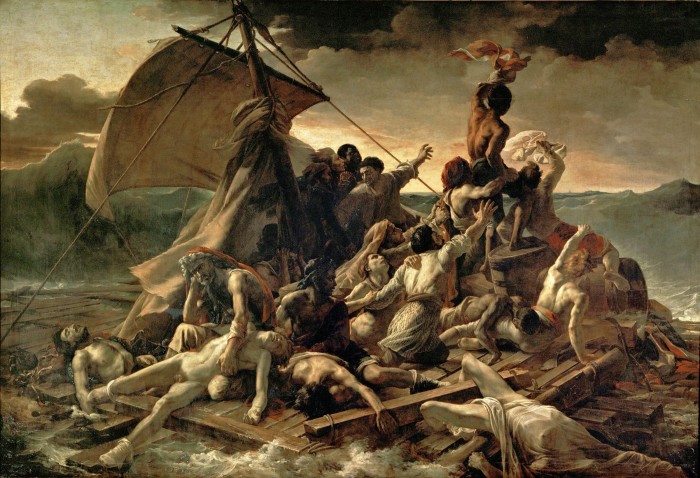
Géricault treated the enormous work as a sacred mission. When it came time for him to move from making compositional studies on paper to the painting itself, he cut off his hair and got to work in a studio full of body parts he had collected from anatomical dissections and the morgue. And he made one critical decision not anticipated in any of the drawings preserved at the Musée des Beaux-Arts in Rouen.
The figure at the very summit of the human pyramid of the alive and the dead became in the finished painting an African, modelled by an actor and acrobat, Joseph — last name unknown. Since Géricault added two more black bodies (only one African was among the survivors), his decision was weighty with moral implications.
Slavery, abolished during the Revolution in 1794, had been restored by Napoleon in 1802. During his brief and entirely expedient conversion to liberalism in 1815 during the Hundred Days he somewhat reversed himself and had followed the British example by abolishing the slave trade. The restored monarchy of Louis XVIII upheld the decree but postponed its implementation for a decade, triggering well-founded suspicions about seriousness of purpose.
Liberals in the national legislature agitated for the immediate enactment of the abolition, and Géricault and his picture became a weapon in their campaign. When the artist showed the painting at the Egyptian Hall in Piccadilly in 1820 (and later in Dublin), it was not just the sensational horror of the story that brought in paying visitors but the sense that the picture was an epic statement about inhumanity.
The message has lost none of its force. The sail of PBoy’s raft is printed with bank notes. The castaways appear drawn from many generations, some with the beards of Bohemian Romanticism, others fitted with today’s life jackets. For Boyart there is a damning continuity between indifference to the plight of those fleeing destitution and war, and the moral squalor of a glamorous art world awash with money. “Art has been stolen from us,” he says. Banksy, who made his own version of the raft, has taken the logic of art activism one stage further. Having drawn the plight of the world’s castaways, he now rescues them with his ship the Louise Michel.
It’s a common objection to politically engaged art that crusading passion comes at the expense of creativity. This is an echo of earlier truisms, first expressed in the aesthetic movement of the late 19th century, which believed art’s vocation was the delivery of beauty, and then a half-century later, by high priests of abstract expressionism such as the critic Clement Greenberg insisting that art’s proper subject was itself.
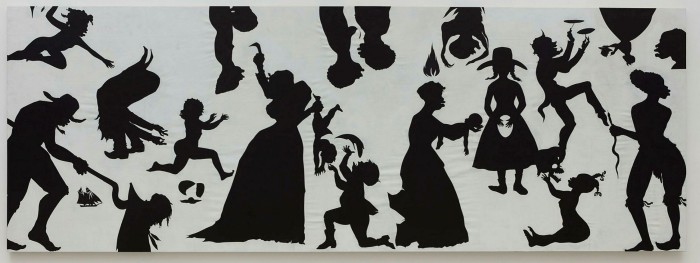
But plenty of the most powerful art of our own day, in effect the return of Romantic engagement, belies that assumption even if it makes for uneasy viewing in the fairs and galleries. Kara Walker’s unsparing silhouettes of American race atrocities, past and ongoing, turn a traditional, sentimental black-and-white medium of book illustration going back to the time of slavery and Jim Crow into a ferocious indictment of a bitter reality that right now shows no sign of fading away.
In Colombia, Doris Salcedo, who has travelled to sites of terrible violence committed by both sides in the long Farc war, has found ways to make domestic furniture — chairs, desks, tables and closets — bear the marks of desolation and abuse. One of the most affecting works shown at her 2018 exhibition at London’s White Cube (which also featured the names of drowned asylum seekers appearing and disappearing in a luminous carpet of what appeared to be wet sand) was a table top shredded to feathery splinters and shards by the impact of an explosion.
It’s no accident, I believe, that so many of the most engaged artists responding to contemporary brutalities are women, since it is so often their homes, their children and their bodies that are the immediate targets of merciless violation. So the sites and objects normally associated with domestic security — furniture, walls and doors — are transformed into machines of terror. When I first saw the cages into which the children of undocumented migrants seeking refuge had been herded by Donald Trump’s immigration enforcers, I thought immediately of the British Palestinian artist Mona Hatoum’s sinister structures of steel bars and electrified wires. Her chamber of horrors is stocked with kitchen utensils, the implements of comfort and sustenance. But scaled up to the size of a hospital folding screen, a cheese grater turns into a shredder of flesh.
Like many of the most committed artists, Salcedo has no illusions about her work’s impact. “I don’t believe an image in and of itself, dispersed and reproduced, can stop violence,” she wrote in 2013, “Art doesn’t rescue . . . What art can do is create an emotional connection that communicates the victim’s experience. It’s as if the victim’s destroyed life, cut short at the time of the murder, might or could in some way continue within the spectator’s experience.”

Wouldn’t it be good if there were just one work of art that made that kind of emotional connection with the casualties of pestilence? In fact, just such a picture was made as Romantic painting was being born in the first decade of the 19th century. Baron Antoine-Jean Gros’s “Bonaparte Visiting the Plague-Stricken in Jaffa”, painted in 1804, has the fearless First Consul as he was in 1799, standing amid the sick, both French soldiers and Arabs in the Armenian monastery of St Nicholas (often misidentified as a mosque), which served as quarantine quarters and hospital during his ill-starred military campaign against the British and Mamluks in Palestine and Egypt. While a terrified officer covers his face to protect himself from the disease Napoleon (in the attitude of the Apollo Belvedere) stretched out his hand to touch a bubo lodged in the armpit of a patient. What an example of self-sacrificing courageous leadership!
Except it wasn’t. Looking forward to his imperial coronation later in 1804, Napoleon wanted an epic image that recalled the thaumaturgic Frankish kings who “touched for the king’s evil”, miraculously curing sufferers of scrofula: the leader as healer as well as general. In reality Bonaparte wanted his men who had caught the plague to overdose themselves to death with opium to spare his army the danger of contagion. And as soon as his depleted army was stranded in Egypt thanks to Nelson’s victory at the Battle of the Nile, off he ran back to Paris, Josephine and the coup d’état that created his dictatorship.
Gros’s Romantic image of the selfless saviour-healer in uniform was one of the many epic lies he would deliver to serve the cause of Napoleonic propaganda. But possibly a twinge of truthful conscience appears in a figure, sitting in deep monochrome shadow, his chin in his hands, staring directly out at the beholder in an expression of anguished resignation. The source of the figure is, inevitably, the lodestar of the Romantics, Michelangelo: a hybrid of the Damned Man in “The Last Judgment” and the Jeremiah on the Sistine Ceiling. The pose had been used before Gros by the Michelangelo-worshipping William Blake, and it would be used again on Géricault’s Raft. It is cold comfort: the human condition at its most pitiful. And not even, not then, not now, a truly self-sacrificing leader anywhere in sight.
Simon Schama is an FT contributing editor. ‘The Romantics and Us’ airs on BBC2 from Friday September 11 at 9pm. He will be discussing the series with FT arts editor Jan Dalley on the concluding evening of the FTWeekend Festival this Saturday at ftweekendfestival.com
Follow @FTLifeArts on Twitter to find out about our latest stories first
Letter in response to this article:
Street art’s depictions of women are oppressive too / From Martin Gargiulo, Shell Chair Professor of Human Resources and Organizational Development, Professor of Entrepreneurship, INSEAD Asia Campus, Singapore
Comments